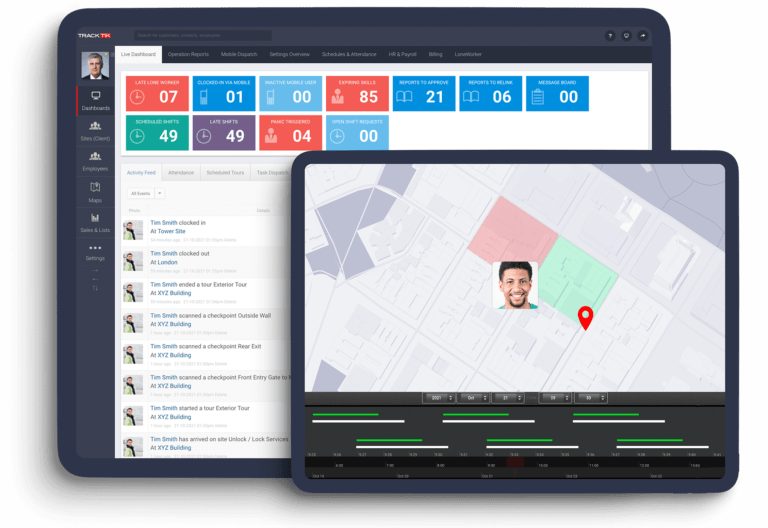Selecting new software to help run your security services company can be a little nerve-wracking.
Like most executives in the industry, you are way more comfortable dealing with security issues than software. Adding to this potential unease may be the thought of what happens if you select an inadequate platform. With so many of your company’s functions and workflows involved, a bad choice can be very costly and may even put your client relationships or business at risk.
But before you reach for a tranquilizer, consider the huge upside: Selecting the right software can be a game-changer for your company, and set it on a new path to significantly greater efficiency and profitability.
So naturally, you want to make sure your firm is carrying out its software search in a sound and systematic way. These are the seven steps we recommend when selecting new software.
1. Get buy-in from executives and key stakeholders.
 Change is an uphill battle. For the software selection and implementation to succeed, senior management and other key stakeholders must support the initiative. They will be the engines that drive the business past the obstacles and resistance that change brings. By consulting key players and end-users among the functions of your organization, you will create a feeling of team solidarity behind the project.
Change is an uphill battle. For the software selection and implementation to succeed, senior management and other key stakeholders must support the initiative. They will be the engines that drive the business past the obstacles and resistance that change brings. By consulting key players and end-users among the functions of your organization, you will create a feeling of team solidarity behind the project.
2. Build an A-level team to plan, budget, and manage the software project.
It may seem painful in the short term to pull your key people away from their regular duties, but mission-critical software impacts so many people and functions in your firm, you do not want to risk putting a potentially expensive process in lesser hands. Working together to plan and budget, your A-level team will set up the search process and make sure the budget is respected. More than the vendor-appointed project manager, your project leader will know all about your processes and take it upon him- or herself to understand the new software system from A to Z. This person will act as the central switchboard for all contact by your employees.
3. Analyze your requirements.
 “Specific is terrific,” as the saying goes, and never more so than at this stage of your search. Define accurately the scope of your project and collect precise requirements for your business processes and systems.
“Specific is terrific,” as the saying goes, and never more so than at this stage of your search. Define accurately the scope of your project and collect precise requirements for your business processes and systems.
This rigor enables vendors to respond exactly to your needs. Being vague, forgetting items that need to be considered, and not involving all your stakeholders in the gathering of requirements will almost guarantee that your budget or timeline or both will blow up on you. Once you have all the requirements in hand, focus on what is most important to you, and document it.
4. Search for vendors.
Would you hire key people without checking their references? Do the same with the vendors you are considering. With three references from happy customers in hand, quiz them on the good and the not-so-good in their experience with the vendor. Shorten your long list of vendors to approximately three solutions. To speed up this process, see the in-depth description of effective short-cuts offered in A TrackTik Guide: How to Separate the Signal from the Noise in Security Workforce Management Software.
5. Test the software in demos.
Ensure that your Demo Script stays consistent for all the vendors so you can compare apples to apples. Be sure they live up to their industry claims! Also, keep in the mind what metrics and reports are important to you. Can the system under consideration produce the metrics and reports you need without customization?
6. Decide on the best software fit for your company.
As you whittle down the vendors on your short list, remember that the right software platform must integrate seamlessly with your existing systems. The best solution offered should also cover both implementation and training, which are the technical and human sides, respectively, of a successful software search.
7. Include change management in your process.
 Well-designed, mission-critical software will change the job descriptions and workflows of many of your people. Your company culture will be affected. To ensure that this upheaval remains under relative control, you will need sensitive leadership, well-planned communication, and effective workshops. Without an investment in change management, resistance to the new platform could reduce the ROI on the whole software project.
Well-designed, mission-critical software will change the job descriptions and workflows of many of your people. Your company culture will be affected. To ensure that this upheaval remains under relative control, you will need sensitive leadership, well-planned communication, and effective workshops. Without an investment in change management, resistance to the new platform could reduce the ROI on the whole software project.
Since so much rides on the workforce management software you select, it is important to commit the right resources and approach to the process. When approaching the selection process in a sound and systematic way, you go a long way to building the foundation for future success.


